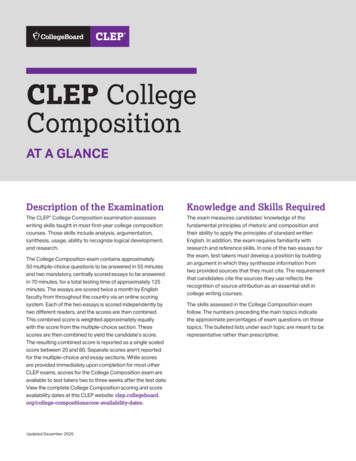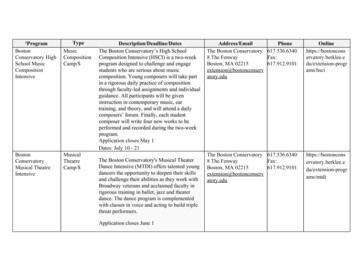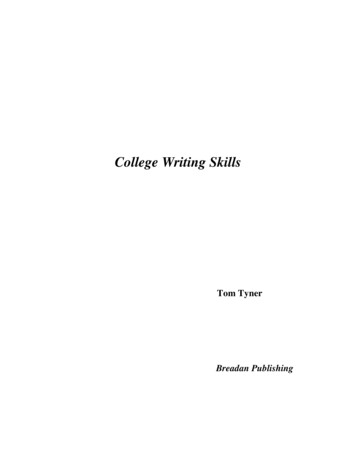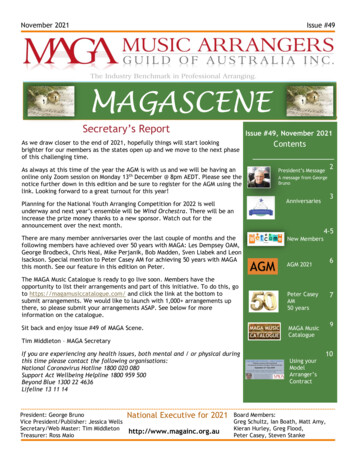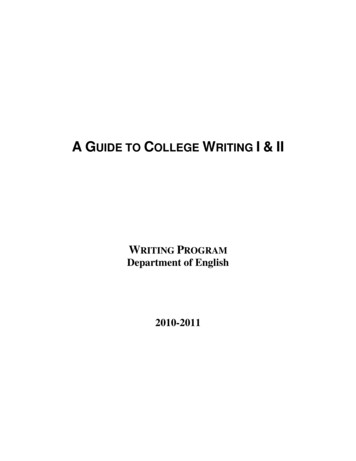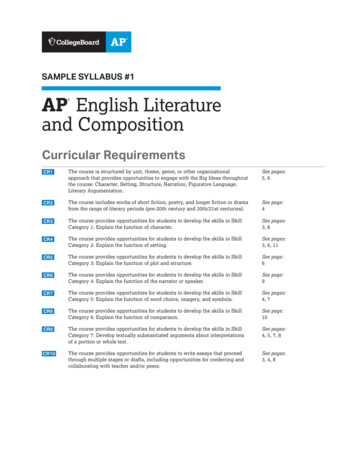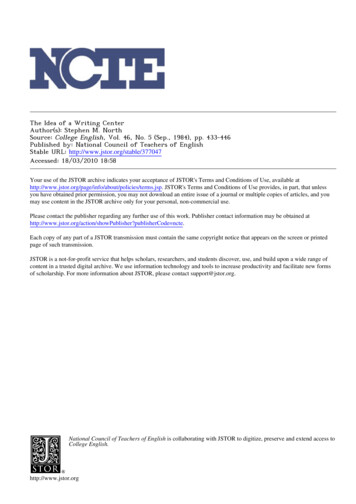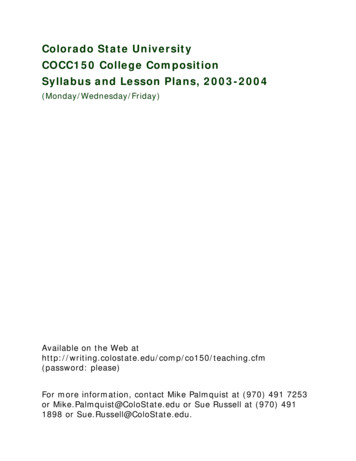
Transcription
Colorado State UniversityCOCC150 College CompositionSyllabus and Lesson Plans, 2003-2004(Monday/Wednesday/Friday)Available on the Web .cfm(password: please)For more information, contact Mike Palmquist at (970) 491 7253or Mike.Palmquist@ColoState.edu or Sue Russell at (970) 4911898 or Sue.Russell@ColoState.edu.
COCC150 College Composition: Daily and WeeklyLesson PlansWelcome to the COCC150 lesson plans. These plans are designed to support your teaching inCOCC150 College Composition, the required first-year composition course at Colorado StateUniversity. COCC150 is equivalent to most “second-semester” composition courses. It focuseson academic writing (including summary, response, analysis, and argument), source evaluation,and source-based writing. The course is heavily influenced by theories of rhetorical situationderived from Lloyd Bitzer and others. It also relies heavily on technology, including theSyllaBase course management system (http://writing.colostate.edu/syllabase/) and an interactive“Writing Room” in the Writing Studio on Writing@CSU (http://writing.colostate.edu/studio).In addition to online resources, COCC150 makes use of two print texts: the Prentice-Hall Guide,6th Edition, and the New York Times, daily national edition. As an instructor for the course, youwill be provided desk copies of both texts.This set of lesson plans provides overall goals for each week of the course. Additionally, eachlesson is conceptually linked to the course goals with a paragraph at the beginning. The firstmonth of the course includes daily lesson plans for courses taught on Monday-WednesdayFriday and Tuesday-Thursday schedules. The specificity of the lesson plans declines as thesemester progresses. The purpose of this arrangement is to encourage you to take ownership ofthe course through the development of your own lesson plans that meet the goals of the courseand reflect your strengths and philosophies as a teacher.Resources that support the teaching of COCC150 are discussed in the following materials. Inaddition to materials found in the textbook, many of the resources are available on thecomposition section of the Writing@CSU Web site (http://writing.colostate.edu/comp/). Othersare available in print form in the appendix of the hard-copy version of this set of lesson plans.You will find the complete set of assignments, including overviews of each portfolio, at the startof each portfolio.COCC150: Course GoalsWe come to CSU with widely varying experiences in writing classes. There are numerous waysto teach writing and to write successfully; as a result, we think it is central to begin a descriptionof the course you will be teaching by clarifying its goals. We hope (and fully expect) that yourteaching styles will differ and that you will make the activities in the common syllabus “yourown,” based on your own writing experiences and knowledge about writing. However, in amulti-sectioned course such as COCC150, common goals ensure a similar educationalexperience for all students in the course. No matter who is teaching an individual section, thefollowing goals should be pursued in all COCC150 classes: Present writing as a process of joining and contributing to a conversation among writersand readers Teach students how to ask questions about their writing (rhetorical) situations so that theymight make the best choices as they produce documents that respond to those situations Teach writing as a process of drafting and revisionCOCC 150 Syllabus Materials 2003-2004Page 2
Teach students to use writing for academic, personal, and civic purposesHow the Four Goals InteractGiven the nature of writing situations, good writing can never be defined universally; rather, theappropriateness of a document can only be evaluated according to the choices a writer makes inlight of his or her writing situation. For instance, is the purpose appropriate for the situation? Isthe text appropriate for the readers’ needs and interests? Is the document organized in a way thatallows readers to follow it? Does the document take into account the social, historical, andcultural contexts in which it will be read? Does the writer recognize and address the limitations,requirements, and opportunities that are part of the writing situation? Rather than teachingwriting as a set of rules on how to produce specific forms—such as a research essay or a reviewof literature—we focus on writing as a process involving questions that shape a writer’s choices.COCC150 is designed to help student writers understand and make informed choices about theirwriting processes and the documents they produce. We assume that, by modeling the process andchoice-making strategies within the contexts we set up in the syllabus, we can help studentwriters apply these ways of thinking to future writing situations. Thus, the writing assignmentsaddressed in the course focus on educated audiences inside and outside the academy. Theassignments help students use writing processes and strategies to write to public audiences forspecific purposes. Moreover, the focus on publicly debated issues throughout the course offers away to help students think about how reading and writing might serve them, not only as studentsin a university but also as educated citizens of a democracy.For these reasons, the conversation metaphor used throughout the course is particularlyimportant. By using this metaphor, we can help students build on their understanding ofconversations as situated within larger social, historical, and cultural contexts. Students realizethat they would be foolish to open their mouths the moment they join a group of people engagedin conversation – instead, they’d listen for a few moments to understand what’s being discussed.Then, if they found they had something to offer, they would wait until an appropriate moment tocontribute. Our students understand what happens to people who make off-topic, insensitive,inappropriate, or ill-considered remarks in a conversation. In COCC150, we build on thisunderstanding by suggesting that, prior to contributing to the debate about an issue, they shouldread and analyze what other writers have written. Then, when they’ve gained an understandingof the conversation about that issue, they can offer their own contribution to it.To become more effective writers, then, students need to ask questions about their writingsituations and make informed choices to respond to those situations. In a nutshell, this coursehelps students engage in the processes of learning what has already been written about a publiclydebated issue, drafting a response to the conversation about the issue, and revising that responseas they consider their writing situation. Learning about the conversation—a process we refer to as becoming an accountablemember of the conversation—involves learning how to read critically, how to writesummaries, how to use textual evidence (e.g., quotation and paraphrase) and evidencefrom personal experience, and how to analyze and evaluate the arguments made by otherwriters. In the first portfolio we will guide students through such a process by carefullyexamining a range of documents related to a single issue, the use of SAT scores as aCOCC 150 Syllabus Materials 2003-2004Page 3
dominant criterion for college admissions. We then transfer the skills of Portfolio 1 intoPortfolio 2, for which students decide on their own debatable, current issues—ideas forwhich will be obtained during the first portfolio by reading about current events in theNew York Times--and then explore varied literature related to it. Learning how to contribute to the conversation—essentially, creating your ownargumentative response to what others have written—involves learning how to generateideas, develop claims and reasons, use evidence effectively, write effective and easy-tofollow prose, and organize documents that meet the needs of a specific context and takeinto account the needs and interests of readers. This will be the principal goal of Portfolio3, for which students will select an audience, purpose, and specific publication context tooffer their argumentative contribution to the conversation. Learning to revise—or learning to assess the effectiveness of a document you’ve writteninvolves rethinking or revising your investment in a particular document and in the ideaspresented within that document. We want students to learn that “revising” means “to resee” rather than to edit or proofread. We understand that the effort entailed in producing adocument can create a sense of attachment by the writer to the ideas and information inthat document. This attachment can make writers reluctant to revise because they mightfear it will distort their meaning. By encouraging and teaching revision, we help studentwriters learn not only how to revise their documents for clarity, completeness, andfinish/polish, but also the value of revising the ideas and meaning within thosedocuments. In short, we encourage them to remain open to the possibility of independentlearning, the kind of revised thinking that can be obtained through serious study,research, reading, thinking, and writing. We also encourage them to think of boththemselves and their audiences as both context/time-bound and continuously reconstructed. While revision is an important part of the entire syllabus, it is particularlyemphasized at the conclusion of Portfolio 3 (the end of the course), when students will beasked to revise their contributions to the conversation (their arguments) for a newaudience, an audience that we assign. Students will be encouraged to see that their owntexts, like texts anywhere, are flexible documents that reflect their current thinking andyet can (and often must) be altered, not just for improvement to content and style, but fordiffering audiences and purposes and as circumstances dictate a revised view of the issue.As students work on their assignments in COCC150, they are likely to find themselveschallenged by the ideas they encounter in their reading about the issue on which they’ve decidedto focus and by their efforts to draft and revise a response to the conversation they’ve decided tojoin. Writers are influenced by social, historical, and cultural beliefs and pressures, whichinfluence their choices as they produce a document. By helping student writers understand thecomplexity of the situations within which they find themselves, we can help students recognizewriting as a social act and view revision as a way to effect change within society. Therefore,students can also begin to see how writing can serve not only academic but also cultural andcivic purposes. To make this interaction of the four goals more concrete, consider the followingexample . . .Writing a paper for a graduate course includes a variety of possible topic choices, such as whichliterary text you will choose, what reading approach you will take, and what aspect of the text ismost important. All of these choices are influenced by the situation in which it was assigned andCOCC 150 Syllabus Materials 2003-2004Page 4
the audience for which it is being written, and includes such factors as what you’ve done in class,the nature of past discussions, and what you believe the professor might expect. Within thiscomplicated writing situation, writers define goals for papers that, hopefully, also have somethingto do with what they want to express about the text to this audience. What such a situationcreates is the need for writers to make a series of choices about the writing task based on anassessment of every aspect of the situation. Each choice limits the other kinds of choices to bemade. If you choose, for instance, to write a feminist analysis of Pride and Prejudice, you’vealready limited which aspects of the novel you might focus on and what kinds of analyses you willhave to conduct. As you clarify your ideas about the phallocentric nature of the “romance,” youmight also have to decide what to include based on what you think your audience will readilyaccept and what you will have to prove in detail. Perhaps you will complete a draft only to decidethe professor is a bit threatened by feminism (because of her cultural experiences andpositioning), so you might then go back and revise the essay to be a bit more attentive to theaudience’s concerns. Or, you might choose to stay with your original analysis to try to confrontthe audience’s possible beliefs more directly. Thus, we can see the interaction of revision andasking questions about the rhetorical context and how they inform a writer’s response to thatcontext.However, the writing process doesn’t really end there. In a larger sense, writing always occurswithin a cultural context. In writing an essay about Pride and Prejudice, you’re also writingabout culture. How does culture view romance? How do cultural forces influence our actionswithin relationships? In effect, as we write, whether we’re aware of it or not, we’re participatingin culture. Writing is a way to gain a voice in the constantly changing nature of society. Yet, inorder for this voice to be authentic, writers must be aware of the social, historical, and culturalcontexts in which they write. If we return to the example above, we see that writing such ananalysis is already analyzing cultural notions of how relationships are affected by thephallocentric culture of the time (e.g., the book may reproduce expectations about gender roleswithin a relationship that was dominant at that time). However, as the writing process unfolds,writers can also express and revise their own views of society and culture. For example, whilewriting a paragraph on how the novel reinforces traditional gender roles, you might be able tosee how those roles are present in your own relationships. While the act of revision changes whatyou’re saying in the text, it also may change your cultural views. If you then decide to stay withyour original analysis rather than revise to more readily fit what you suspect are the views of theprofessor, you could make an active and direct attempt to change cultural notions of gender roleswithin relationships, thus representing your own (revised) beliefs more accurately.Final ThoughtsWe begin our common syllabus with this philosophical statement because it is easy, once youbegin teaching, to focus only on how to produce the particular kinds of documents asked for inthe major writing assignments. Keeping the goal of teaching choice within a context, however,can help prevent too much focus on producing an “A” paper of a particular genre. While successin particular genres will no doubt help your students succeed in COCC150, it will not necessarilyCOCC 150 Syllabus Materials 2003-2004Page 5
help them succeed in writing tasks beyond this individual class—the main purpose of a first-yearcourse.Although much of this syllabus focuses on specific essays and reports, it is important to keep inmind that the goal of COCC150 is not simply to teach students to write these particular kinds ofdocuments well. Although COCC150 is meant to help students write for other courses, thevariety of genres and assignments across the curriculum cannot be readily reproduced in thiscourse. Instead, the major goal of COCC150 is to teach students about writing in such a way thatthey can respond effectively to a variety of writing assignments, contexts, and tasks in the future.Therefore, we have designed the course so that students must choose and analyze real writingsituations. Our hope is that this will help students learn how to apply academic thinking andwriting strategies to new, more public contexts. In short, then, the main goal of the course is tocreate better writers rather than writers proficient only at producing certain kinds of documents.COCC 150 Syllabus Materials 2003-2004Page 6
Portfolio 1: Introduction to Goals and EssayAssignment SheetsCOCC 150 Syllabus Materials 2003-2004Page 7
Overview of Portfolio 1: Developing Accountability.Understanding the Conversation through Critical Reading.Writing a Summary/Response for an Educated, PublicAudienceGoals of Portfolio 1 include our desire to:1. Develop student awareness of texts as ongoing conversations on issues of importance andrelevance to themselves and the world2. Develop engagement in the world of both problems and ideas through reading of a majornational newspaper and to reassure students of their ability--and indeed their responsibility asadult citizens--to participate in the development of ideas and actions that contribute toimprovements and solutions3. Develop student awareness of texts as products of particular purposes, audiences, andcontexts (rhetorical situations) and develop student ability to read such texts critically4. Develop student accountability to ongoing conversations by encouraging them to readwidely, to develop positions based on knowledge and critical reading rather than onunchallenged opinions5. Teach students the principles of objective, academic summary of texts as a basis for effectiveresponses6. Teach students how to focus and develop their own texts (response essays) for educatedaudiences7. Teach students how to make choices about the content and development of their writingbased on context8. Teach students how to incorporate their own experiences into their responses while alsomoving outside the self to incorporate knowledge gained from other sources (text evidence)9. Teach students how to do deep (global rather than merely local or stylistic) revision of theirwriting.10. Introduce students to the conventions associated with citing sources.COCC 150 Syllabus Materials 2003-2004Page 8
COCC150: Portfolio 1 Essay AssignmentWrite a summary/response to an article that’s part of the discussion on the issue ofSAT Use in College Admissions. This summary/response should be written as anextended Letter-to-the-Editor of the New York Times (750-1000 words) and shouldbe accompanied by a compressed version (or abstract) of the same letter but of alength not exceeding 200 words, which is the typical length of the edited versionsof published letters to the NYT.Introduction: To complete this portfolio, you will read, summarize, and respond to variousarticles about a publicly debated issue, specifically the ongoing debate over use of the SAT as amajor criterion for admission to universities. Then you will select one of your summary/responseessays to revise and polish into a form appropriate for an extended New York Times Letter to theEditor. You will then reduce this extended letter and generate an “abstract” or mini-letter ofapproximately the length published by the Times.Workshop Draft Due Date: September 1, 2003Due Date: September 2, 2003Worth: 20% of your final gradePurposes for this Portfolio: To understand and critically examine a written argument; tocommunicate an author’s argument and your response to that argument.Audience: Address your essay to typical readers of the New York Times, which you can assumeis a general, though well-educated, audience. Your essay will take the form of a Letter-to-theEditor of the New York Times. Assume that your audience has not read the article you’reresponding to, although they are likely to be familiar with the issue, in part because it has beendealt with to some extent in the Times. (Specifically, the Diana Jean Schemo article published bythe Times, laid out the basics of the debate and documented an excerpt from the proposal madeby Dr. Richard C. Atkinson, President of the University of California system.) Therefore, youraudience can be assumed to know only as much about the debate as the Schemo article describes.Therefore, they will need for you to provide a summary of the article you’re responding to andmake a connection—however brief--somewhere in your letter to the Schemo article. Thisaudience will expect you to thoroughly support and explain each point you make in response tothe article you’ve selected. In addition, they will expect you to use a reasonable tone and showrespect for your readers and sources by avoiding slang. You can assume that certain style andformatting decisions (such as abbreviation and citation methods) will be made by editors of theTimes. You should therefore apply MLA style guidelines and allow the editors at the Times torevise as they see fit. You should think of this letter as a specific application of the principles ofsummary and response writing, generated for a particular context--a Letter-to-the-Editor of theNew York Times. Once you’ve completed your extended letter, you should write a very briefversion of it—like an abstract to an article—of 200 words, since this length is more typical ofthe letters published by the Times.Portfolio Content: Please submit your essay in a folder clearly labeled with your name andemail address. Your portfolio should include: The final draft of your polished summary/response essay, formatted with one-inchmargins, double-spaced lines, and a readable 12-point fontCOCC 150 Syllabus Materials 2003-2004Page 9
The final draft of your mini-letter ( 200 words), anticipating the length the Times will cutyour letter to All rough drafts of your polished summary/response essay Your initial summaries and/or responses to the assigned articles (these will be completedas part of the homework for this portfolio) Workshop comments you received from classmatesEssay Requirements: It is understood at the outset that your letter would be compressed orreduced if it were published in the NYT. Therefore, it is not necessary for you to worry aboutyour extended letter being too long for the context. You should write a full letter, of 750 to 1,000words in length. This letter will be a specific application of summary and response principles,written for the specific context of the Times. Roughly one-third of the letter should be devoted tosummary. In your summary, clearly identify the article to which you are responding and providea fair and accurate description of the author’s purpose and main ideas and connect this summaryto the Schemo article, which your readers will be familiar with. Your response to the article canindicate that you agree or disagree with the article, have applied interpretation/reflectionprocesses or have analyzed the article. You should clearly state your main and supporting pointsin your response. You should support your points with evidence (personal experience,information from sources, and analysis/explanation). Your second, shortened version of the letterwill compress the focus of your longer letter, and will necessarily move more quickly intoresponse.Grading Criteria: I will check your portfolio for completeness. In addition to checking yourprocess materials, which document your steady progress and engagement, I will ask myself thefollowing questions as I read your extended Letter-to-the-Editor (#16 applies to your shortenedversion of the letter):1. Have you clearly identified the article and author in your summary?2. Have you clearly identified the main point of the article in your summary?3. Have you clearly identified other key points related to the main point?4. Have you used quotations and paraphrases effectively in your summary?5. Have you attributed information to the author in your summary (using author tags)?6. Have you clearly identified your main point in your response?7. Does your response focus on the main point you are making?8. Does your main point indicate a clear understanding of the essay you are summarizing? (Inother words, are you responding to a key idea or main point made by the author of the essayyou are summarizing?)9. Have you used quotations and paraphrases effectively to support your main point?10. Have you provided (if appropriate) personal experience as evidence to support your mainpoint?11. Have you provided reasons to support your main point and backed up those reasons withevidence or analysis?COCC 150 Syllabus Materials 2003-2004Page 10
12. Have you organized your response in a reasonable manner? (In other words, a manner thatyour readers should find easy to follow.)13. Are your summary and response written to a general, though well-educated audience such aswe would expect to be readers of the New York Times?14. Are your summary and response written in a form that conforms to standard AmericanEnglish? (In other words, is it generally free of grammatical, mechanical, and spellingerrors?)15. Have you applied standard MLA citation method (as needed)?16. As I read your mini-letter (abstract), I will evaluate its success at reducing the content of youroverall response to a much shorter form. I will ask: Does the shortened version capture theessence of your overall point? Does it seem publishable in the NYT?Articles: We will read the texts listed below during our work on this portfolio. For your responseyou will choose either the Atkinson full speech (primary source) or the Sacks, Williams,Bollinger, or Thernstrom essay (secondary sources about Atkinson’s speech) to respond to. “Head of U. of California Seeks To End SAT Use in Admissions” by Diana Jean Schemoin The New York Times, February 17, 2001, A1 . “SAT Speech” by Dr. Richard C. Atkinson. Available from the web page of theUniversity of California Office of the h.html or .html “SAT—A Failing Test” by Peter Sacks in the Nation (04/02/2001) or “RadicalsUndermine College Admissions Criteria” by Walter E. Williams in Human Events 58.13on 04/08/02 “Debate Over SAT Masks Perilous Trends in College Admissions” by Lee Bollinger.Published in the Chronicle of Higher Education 48.44 on 07/12/02 or “AdmissionsImpossible” by Abigail and Stephan Thernstrom in the National Review 53.5 on 3/19/01. A few additional NYT articles, editorials, op-ed pages, and letters-to-the-editor on thesubject of the SAT to get a sense of the conversation as well as to familiarize you withthe style and formality of writing in the NYT.Additional optional readings with descriptive and evaluative annotations in MLA form:Atkinson, Richard C. “Achievement Versus Aptitude in College Admissions,” Issues in Scienceand Technology 18.2 (Winter 01/02), 31-36.In this article, published subsequent to Atkinson’s proposal and the uproar that followed, RichardC. Atkinson, President of the University of California system, clarifies his position on the SATs,noting for instance his general support for standardized testing, although not the SAT I whenused for admissions purposes. Atkinson’s article includes a valuable set of additional,recommended readings in the bibliography.Lemann, Nicholas, “The SAT Meritocracy,” Washington Monthly 29.9 (September 1997), 32-36.COCC 150 Syllabus Materials 2003-2004Page 11
Lemann, a regular columnist for the Atlantic Monthly, is author of several criticisms of Americaneducation and is particularly concerned about entrenched class-ism in U.S. schooling. Lemann’sarticle presents a stinging condemnation of the SAT’s tendency to reward the “mandarin elite.”This article was written before Atkinson’s proposal and may be particularly valuable as arepresentative voice of those who criticized the SAT before Atkinson’s well-publicized proposal.COCC 150 Syllabus Materials 2003-2004Page 12
Week 1: Monday, August 25th – Friday, August 29thGoals for this WeekYou have eight primary goals for this week:1. Take care of the administrative work of making sure students are enrolled in the course andhave a syllabus.2. Introduce the overall goals of COCC150 and make sure that your students understand thosegoals and how the sequences of activities, homework, and assignments will help them reachthose goals. Clarify due dates for each portfolio so that they can record these on their mastercalendar.3. Establish your policies. Make sure to establish your policy on homework collection,attendance, late portfolios, and the revision of portfolios. These will be discussed during theorientation week and in your teaching methods course, E684.4. Provide students with an overview of the primary concepts that will be used in the course: the writing situation model, which highlights the text, writers’ purposes, readers’ needsand interests, limitations and opportunities, and social/cultural/historical contexts the notion of writing as participation in a conversation; the importance of becomingaccountable to what others have written and the subsequent need to offer something newto the conversation the role of public discourse in society and the obligation to understand the complexity ofthe writing situations shaping public discourse5. Introduce students to the key instructional resources they will be using during the course,including the Prentice Hall Guide, the SyllaBase course page(http://writing.colostate.edu/syllabase/), Writing@CSU (http://writing.colostate.edu),especially the bibliography and drafting functions of Writing Studio, and the New York Timesnational edition.6. Assign a homework assignment, which students will post to the Class Discussion Forum ontheir SyllaBase course page. You should read the work produced by your students withattention to their overall writing abilities. If you find students who have what appear to befairly weak writing skills, pay particular attention to subsequent homework and, ifappropriate, meet with them and develop a plan to enhance their writing skills. You mightsuggest that the student work with consultants in the Writing Center or you might set upindividual meetings during your office hours.7. Introduce students to critical reading strategies and to the principles of summary writing. Asyou introduce summaries, address the concept of “objectivity” in summarizing and discussthree types of summaries: main point, key point, and outline summaries. However, it’scritical that students understand that “objectivity” in an abso
COCC150 College Composition, the required first-year composition course at Colorado State University. COCC150 is equivalent to most "second-semester" composition courses. . We come to CSU with widely varying experiences in writing classes. There are numerous ways to teach writing and to write successfully; as a result, we think it is .
